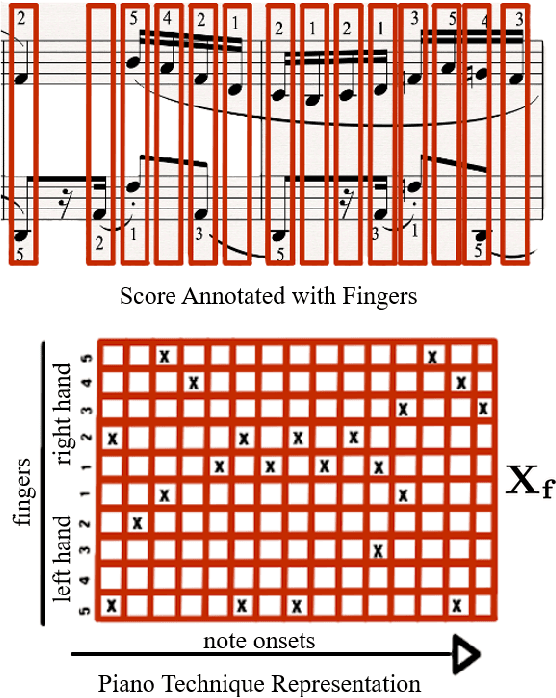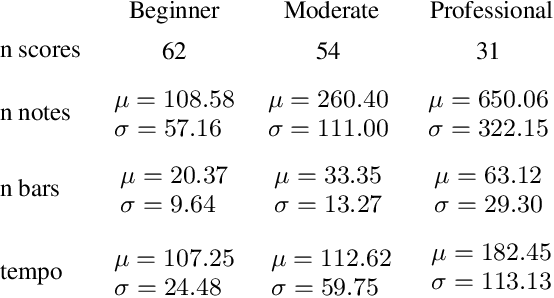Vsevolod Eremenko
Towards Explainable and Interpretable Musical Difficulty Estimation: A Parameter-efficient Approach
Aug 01, 2024Abstract:Estimating music piece difficulty is important for organizing educational music collections. This process could be partially automatized to facilitate the educator's role. Nevertheless, the decisions performed by prevalent deep-learning models are hardly understandable, which may impair the acceptance of such a technology in music education curricula. Our work employs explainable descriptors for difficulty estimation in symbolic music representations. Furthermore, through a novel parameter-efficient white-box model, we outperform previous efforts while delivering interpretable results. These comprehensible outcomes emulate the functionality of a rubric, a tool widely used in music education. Our approach, evaluated in piano repertoire categorized in 9 classes, achieved 41.4% accuracy independently, with a mean squared error (MSE) of 1.7, showing precise difficulty estimation. Through our baseline, we illustrate how building on top of past research can offer alternatives for music difficulty assessment which are explainable and interpretable. With this, we aim to promote a more effective communication between the Music Information Retrieval (MIR) community and the music education one.
Combining piano performance dimensions for score difficulty classification
Jun 14, 2023Abstract:Predicting the difficulty of playing a musical score is essential for structuring and exploring score collections. Despite its importance for music education, the automatic difficulty classification of piano scores is not yet solved, mainly due to the lack of annotated data and the subjectiveness of the annotations. This paper aims to advance the state-of-the-art in score difficulty classification with two major contributions. To address the lack of data, we present Can I Play It? (CIPI) dataset, a machine-readable piano score dataset with difficulty annotations obtained from the renowned classical music publisher Henle Verlag. The dataset is created by matching public domain scores with difficulty labels from Henle Verlag, then reviewed and corrected by an expert pianist. As a second contribution, we explore various input representations from score information to pre-trained ML models for piano fingering and expressiveness inspired by the musicology definition of performance. We show that combining the outputs of multiple classifiers performs better than the classifiers on their own, pointing to the fact that the representations capture different aspects of difficulty. In addition, we conduct numerous experiments that lay a foundation for score difficulty classification and create a basis for future research. Our best-performing model reports a 39.47% balanced accuracy and 1.13 median square error across the nine difficulty levels proposed in this study. Code, dataset, and models are made available for reproducibility.
Score difficulty analysis for piano performance education based on fingering
Mar 24, 2022



Abstract:In this paper, we introduce score difficulty classification as a sub-task of music information retrieval (MIR), which may be used in music education technologies, for personalised curriculum generation, and score retrieval. We introduce a novel dataset for our task, Mikrokosmos-difficulty, containing 147 piano pieces in symbolic representation and the corresponding difficulty labels derived by its composer B\'ela Bart\'ok and the publishers. As part of our methodology, we propose piano technique feature representations based on different piano fingering algorithms. We use these features as input for two classifiers: a Gated Recurrent Unit neural network (GRU) with attention mechanism and gradient-boosted trees trained on score segments. We show that for our dataset fingering based features perform better than a simple baseline considering solely the notes in the score. Furthermore, the GRU with attention mechanism classifier surpasses the gradient-boosted trees. Our proposed models are interpretable and are capable of generating difficulty feedback both locally, on short term segments, and globally, for whole pieces. Code, datasets, models, and an online demo are made available for reproducibility
 Add to Chrome
Add to Chrome Add to Firefox
Add to Firefox Add to Edge
Add to Edge